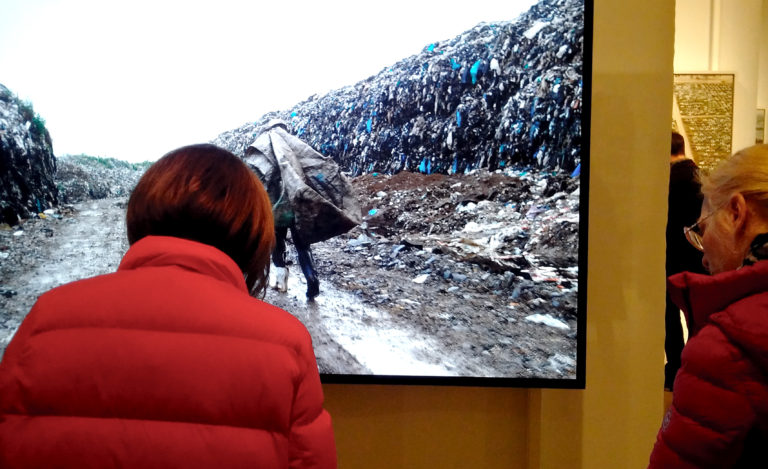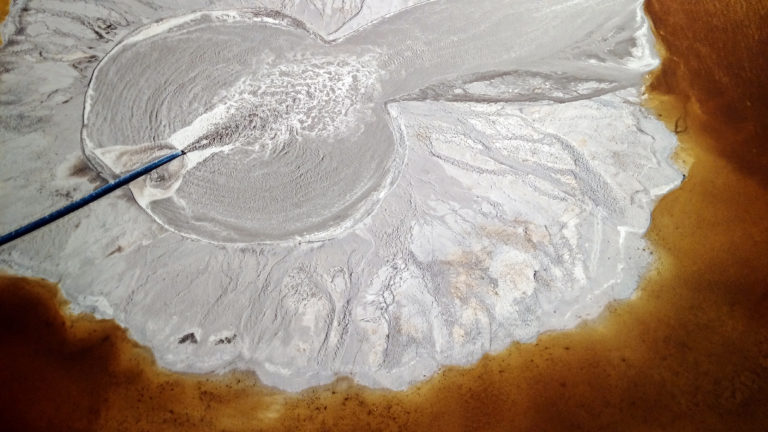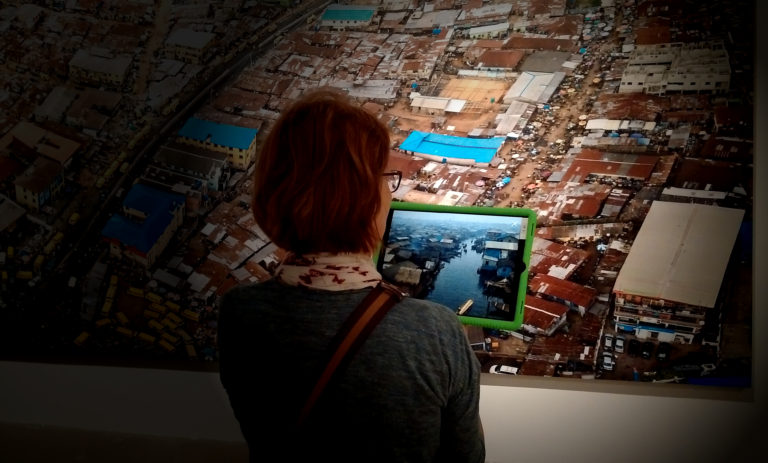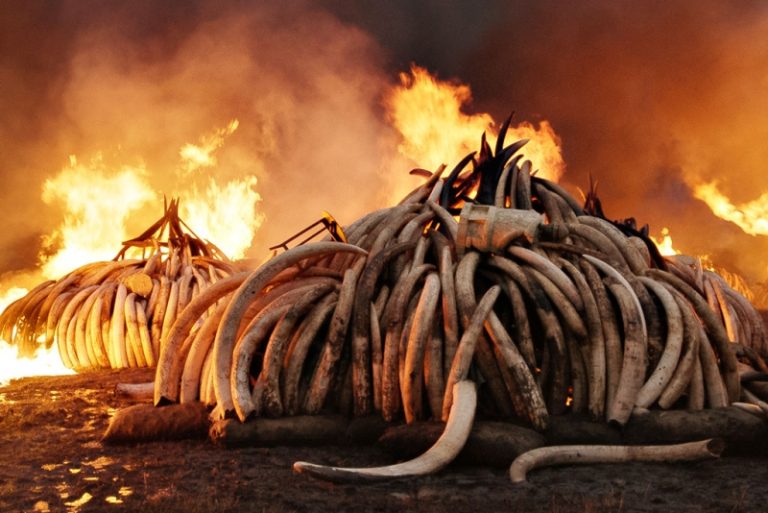ART GALLERY OF ONTARIO (AGO) exhibit Anthropocene (works by Burtynsky, Baichwal and de Pencier). Photo (above): by Edward Burtynsky; ‘Dandora Landfill 3 Plastics Recycling, Nairobi, Kenya’

Upon entering the exhibit area, one is introduced to a looping video on a large screen (left). It shows the laggard strides of a man who’s assumedly off to his routine task as the camera follows with a slow, tired creep. We watch as he walks with a hampered gait between embankments of layered garbage, burdened with a large tarp/bag that hangs from his shoulder.
We watch as he walks with a hampered gait between embankments of layered garbage, burdened with a large tarp/bag that hangs from his shoulder. His path, like a stream that once randomly set its course by sheer force, cuts into this canyon of garbage. Perhaps, his destiny—borne out from necessity—now mirrors our collective course. We can assume that he’s off to his unimaginable recycling “job,” one that will provide a living, something that ironically sustains his life from bundles of refuse. We understand that the only reason why someone would enter such an area is to scavenge a usable scrap; to salvage a grain of hope from a pile of bad ideas. Perhaps, this is the visual that sends the message of humanity’s now Sisyphean task of reversing, if not just healing, the scars of the Anthropocene.
This multimedia exhibit at the Art Gallery of Ontario (AGO) in downtown Toronto is from renowned photographer Edward Burtynsky, and filmmakers Jennifer Baichwal and Nicholas de Pencier. The exhibit is entitled Anthropocene (a proposed term to describe the period of man’s initial destructive effect on the planet) and it also coincides with the release of Anthropocene: A Human Epoch, a full-length documentary film co-directed by all three of the aforementioned, which can also be seen at the AGO’s screening rooms.
It’s not that we haven’t seen photography or film like this before (think Koyaaniqatsi (1982); Powaqqatsi (1988); Baraka (1992); Petropolis: Aerial Perspectives of the Alberta Tar Sands 2009; Lessons of Darkness (1992) et. al) including work from Sebastião Salgado and from Burtynsky himself, but these images—although lacking in their shocking punch as they once did—still trigger introspection if not disgust in the viewer.
One is still lured to the fine details and colours of Burtynsky’s photography; colours that have been excavated seemingly out of imagination but in reality are man-made recipes comprised of ingredients pilfered from their earthly domain. These chromatic examples are most evident in Burtynsky’s photos of tailings and of copper and lithium mines, all of which radiate from the gallery walls in a palette unrecognized by the conventional colour codes of our minds. The process of mineral extraction and their resultant tailings are without doubt vivid toxic pools, fueled by our current global market that demands it; however, the ecological destruction as presented in Burtynsky’s photographs are without question perversely beautiful in their aesthetic. The content is repulsive, but if one lets the mind wander, to surrender to some of the abstraction within the frame, they might inversely be intrigued by the absence of detail—as though this is all supernatural and beyond our control or understanding. Equally intriguing—and this is the power of photography over moving images—is what exists outside the single frame. Looking at a still photograph of tailings, you’re left to wonder what other horrors exist beyond the periphery; examining and pondering if this supposed nightmare is worse than imagined.

The content is repulsive, but if one lets the mind wander, to surrender to some of the abstraction within the frame, they might inversely be intrigued by the absence of detail—as though this is all supernatural and beyond our control or understanding.
As part of a multimedia exhibition, Burtynsky’s photography triumphs. While Baichal has a long history of documentary filmmaking, her clips with de Pencier that run on several screens, although appropriate, feel a little misplaced. Rather than seamlessly complement Burtynsky’s stills as part of a unified theme, the video clips are more distinct in that they inform rather than evoke: where Burtynsky’s photos exalt and aid contemplation in their stillness, the video clips—perhaps by dint of their inherent motion—are standalone and unaroused in their particular realism. The videos slip into the realm of a distantly cold editorial, possessing a quality more akin to a newsreel, whereas Burtynksky’s photography slips the viewer into something more unconsciously immersive. As an example, both Baichwal and de Pencier are credited for attaching a camera to the front of a train that rockets inside the Swiss Alps, through the Gotthard Base Tunnel, the world’s longest railway tunnel.
The footage feels gimmicky and perhaps unnecessary: countering the idea of unconscionable and irreparable planetary destruction, it illustrates mankind’s ability to create a more eco-friendly mode of transportation. In other words, this is an example of minimal, if not mitigated destruction, as an alternative for a greater common good. Nonetheless, it still adheres to the exhibit’s overall message of presenting the Anthropocene as a series of facts than as an excessive moral message. Baichwal’s talents and strengths are as writer/director, and one can suspect that Anthropocene: A Human Epoch is where these clips best belong; in one unified, lyrical documentary, as she often executes with beautiful plaintive artistry, reminiscent in Watermark (2013) and Manufactured Landscapes (2006).
The collaboration and curation here still comes together as a collective theme for an exhibit, one that sufficiently editorializes the subject matter while still evoking the viewer to generate a healthy discussion or even to ‘provoke change’ as Baichwal describes.
“We have always taken from nature. This is normal, part of the human condition and, indeed, a fact of life for all life forms. What is different today is the speed and scale of human taking, and that the earth has never experienced this kind of cumulative impact. If my images appear surreal at times, it must be remembered that they depict out extractive world as it is.”
— Edward Burtynsky
“The Anthropocene Project is a culmination of all the conversations we have ever had about art’s capacity to provoke change, as well as the merits and drawbacks of doing this experientially: to not preach, harangue or blame, but to witness, and in that witnessing, try to shift consciosness.”
— Jennifer Baichwal
“It is my responsibilty to use my camera as a mirror, not a hammer: to invite viewers to witness these places and react in their own individual fashion.”
— Nicholas de Pencier
The above quotes were taken from the walls of the exhibition: their collective mission (Burtynsky, Baichwal, and de Pencier) is to “shift consciousness” rather than be confrontational and accusatory, to stimulate discussion rather than simply make guilt-conscious our self-imposed, hyper-scaled demise. It’s difficult to see the exhibit as just a mere presentation of facts without an explicit message, which de Pencier suggests isn’t being ‘hammer’-ed home but instead mirrored back to us. Even so, the call to action here doesn’t feel over-the-top, even when presented with the visual facts. We’re not mere witnesses, but we’re also directly and indirectly collaborators and participants; even the loudest environmentalist uses a computer, a cell phone or other industrialized product, each and every day.
Burtynsky’s use of the word ‘surreal’—an often overused descriptor of things that seem more unreal or an exaggerated extension of the real—seems inappropriate here, for images that are so grounding and sobering to the viewer in their unadulterated presentation of reality. However, by using augmented reality throughout the exhibition, particularly with the ability to insert oneself alongside the plight of the white rhino or within the frame of a pile of elephant tusks, the content does become increasingly surreal as one virtually partakes and witnesses current and soon-to-be vestiges of the animal kingdom.


The Anthropocene exhibit makes use of augmented reality with an app called Avara. With an iPad, or with a smartphone, you simply point the device towards the assigned area of a particular work, which then triggers the app for additional content. The AGO also offers iPads if you choose not to download the app to your phone.
The always irrevocable composition of our humanity in relation to pollution is where Burtynsky sprouts his thesis; consumption means sustaining life but it also means destruction on which we consume. What are we to make of men sifting through piles of crushed plastic, or of dogs nestled atop garbage within the same tableau as comfortably as they would in one’s living-room? This is evidenced in what is arguably the strongest photo in the collection: ‘Dandora Landfill 3’ taken at a plastic recycling facility in Nairobi, Kenya. It’s not to be missed for its repulsion and revelatory detail; candy-coated colours that pervade the eye in a classic composition. The eye and mind never tire. The colours feel saturated, and from a distance the photo appears more abstract and even painterly. The message isn’t ‘hammered’ toward us, nor is it amplified, perhaps because we’ve seen this in other works. Our desensitized faculties—dulled by visuals for which we all have contributed—are perhaps too far gone now to have these images resonate with shock.
The photos inform as much as they mesmerize. On the one hand, it is awe-inspiring to see the scale and capability to which mankind can create colossal ecological change. Progress comes at a cost, but the “revelatory” nature of the exhibit should perhaps occasion in all of us some reflection as to how that cost can be mitigated; and the “speed” in which we disfigure our planet’s landscape should be equaled in how we use our collective force to heal what has already been torn.
“I still believe that lateral exploration, open-minded conversation, can provoke transformation more deeply than hard argument.” — Jennifer Baichwal
It’s not all gloom and doom here, as Baichwal appropriately describes that ‘lateral exploration’ within healthy discourse can foster positive results. The strength of the exhibit is perhaps it too is a lateral exploration by all three artists in this sprawling exhibition, and as long as we participate in viewing the work we’re addressing our ability and desire to be self-aware.
—————————————————————————————
Anthropocene goes on until January at the Art Gallery of Ontario in Toronto. Burtynsky’s works have been shown at Howard Greenberg Gallery in New York, Sundaram Tagore Gallery in Singapore and Hong Kong, and Galerie Springer Berlin, among many others. Burtynsky, Baichwal, and de Pencier, all of whom are Canadian, have previously collaborated in the acclaimed documentaries Manufactured Landscapes (2006) and Watermark (2013).


